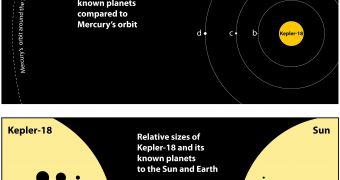Astronomers using the NASA Kepler Telescope have recently discovered several extrasolar planets in orbit around a nearby star, called Kepler-18. The three identified planets orbit closer to the surface of their parent star than Mercury does to the Sun.
The investigators were led by expert Bill Cochran, who is an astronomer at the University of Texas in Austin. According to his team, the Sun-sized star features three companions, of which two are about the size of Neptune, and one was found to be a super-Earth.
Kepler-18b is the most Earth-like planet of the bunch, but it still dwarfs our home world when compared directly. Details of the discovery were presented yesterday, October 4, in Nantes, France.
The team participated in the joint meeting of the American Astronomical Society’s (AAS) Division of Planetary Science and the European Planetary Science Conference. A paper describing the findings will also be published in a November issue of the Astrophysical Journal Supplement Series.
Measurements conducted with Kepler's sensitive instruments have determined that Kepler-18, while only 10 percent larger than the Sun, contains only 97 percent of the solar mass. The team also revealed that more in-depth studies could reveal even more exoplanets in this system.
Kepler-18b is the closest planet to the star, completing a full orbit in just 3.5 days. It is twice as large as Earth, and about 6.9 times heavier. Similar to all of its companions, there is no chance that this world is inhabited or inhabitable due to the searing temperatures that bathe its surface.
Kepler-18c is located slightly farther away from the star, needing nearly 15 days to complete a full orbit. It tips the scales at 17 times the mass of Earth, and exceeds our planet's diameter 5.5 times over.
Kepler-18d is about 7 times larger than our world, but is slightly lighter than exoplanet c, at only 16 Earth masses. The two Neptune-like planets spin in concert around their parent star, Kepler found.
Cochran says that Kepler-18 c and d are in a 2:1 resonance, given that the former orbits the star twice for every full rotation the latter makes. However, they “are not staying exactly on that orbital period,” the team leader explains.
“One is slightly early when the other one is slightly late, [then] both are on time at the same time, and then vice-versa. It means they’re interacting with each other. When they are close to each other […] they exchange energy, pull and tug on each other,” he concludes.
The McDonald Observatory at UTA was used to recheck Kepler's measurements, and confirm that the three worlds were indeed there.

 14 DAY TRIAL //
14 DAY TRIAL //